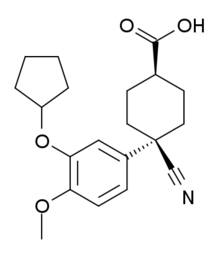Cilomilast
Cilomilast je organsko jedinjenje, koje sadrži 20 atoma ugljenika i ima molekulsku masu od 343,417 Da.[1][2]
 | |
| Klinički podaci | |
|---|---|
| Drugs.com | Monografija |
| Identifikatori | |
| CAS broj | 153259-65-5 |
| ATC kod | None |
| PubChem | CID 151170 |
| DrugBank | DB03849 |
| ChemSpider | 133238 |
| Hemijski podaci | |
| Formula | C20H25NO4 |
| Molarna masa | 343,417 |
| |
| |
Osobine uredi
| Osobina | Vrednost |
|---|---|
| Broj akceptora vodonika | 5 |
| Broj donora vodonika | 1 |
| Broj rotacionih veza | 5 |
| Particioni koeficijent[3] (ALogP) | 4,2 |
| Rastvorljivost[4] (logS, log(mol/L)) | -5,1 |
| Polarna površina[5] (PSA, Å2) | 79,5 |
Reference uredi
- ^ Knox C, Law V, Jewison T, Liu P, Ly S, Frolkis A, Pon A, Banco K, Mak C, Neveu V, Djoumbou Y, Eisner R, Guo AC, Wishart DS (2011). „DrugBank 3.0: a comprehensive resource for omics research on drugs”. Nucleic Acids Res. 39 (Database issue): D1035—41. PMC 3013709 . PMID 21059682. doi:10.1093/nar/gkq1126.
- ^ Nucleic Acids Res (2008). „DrugBank: a knowledgebase for drugs, drug actions and drug targets”. Nucleic acids research. 36 (Database issue): D901—6. PMC 2238889 . PMID 18048412. doi:10.1093/nar/gkm958.
|first2=zahteva|last2=u Authors list (pomoć);|first3=zahteva|last3=u Authors list (pomoć);|first4=zahteva|last4=u Authors list (pomoć);|first5=zahteva|last5=u Authors list (pomoć);|first6=zahteva|last6=u Authors list (pomoć);|first7=zahteva|last7=u Authors list (pomoć);|first8=zahteva|last8=u Authors list (pomoć) - ^ Ghose, A.K., Viswanadhan V.N., and Wendoloski, J.J. (1998). „Prediction of Hydrophobic (Lipophilic) Properties of Small Organic Molecules Using Fragment Methods: An Analysis of AlogP and CLogP Methods”. J. Phys. Chem. A. 102: 3762—3772. doi:10.1021/jp980230o. Arhivirano iz originala 22. 07. 2014. g. Pristupljeno 13. 12. 2013.
- ^ Tetko IV, Tanchuk VY, Kasheva TN, Villa AE (2001). „Estimation of Aqueous Solubility of Chemical Compounds Using E-State Indices”. Chem Inf. Comput. Sci. 41: 1488—1493. PMID 11749573. doi:10.1021/ci000392t.
- ^ Ertl P.; Rohde B.; Selzer P. (2000). „Fast calculation of molecular polar surface area as a sum of fragment based contributions and its application to the prediction of drug transport properties”. J. Med. Chem. 43: 3714—3717. PMID 11020286. doi:10.1021/jm000942e.
Literatura uredi
- Hardman JG, Limbird LE, Gilman AG (2001). Goodman & Gilman's The Pharmacological Basis of Therapeutics (10. izd.). New York: McGraw-Hill. ISBN 0071354697. doi:10.1036/0071422803.
- Thomas L. Lemke; David A. Williams, ur. (2007). Foye's Principles of Medicinal Chemistry (6. izd.). Baltimore: Lippincott Willams & Wilkins. ISBN 0781768799.